What does it mean to be an innovative, responsive leader in your community? The most successful school and district leaders are those who have the tools and mindset to develop communities in which teacher-led innovation is fostered, supported, empowered and celebrated. The good news is that you have the power to create this kind of leadership in your district and schools.
Your journey to turn this potential into reality begins with a robust understanding of how you can become a more innovative leader and help other leaders emerge.
Based on our experience working with over 950 schools and 200 districts across the US., we have created this guide to provide a curated set of resources and to offer valuable insight on the importance of innovative leadership in education, some of the most commonly faced issues, the competencies required to be successful, what real responsiveness looks like and what you can do to gain buy-in and begin implementing innovative leadership development in your school or district.
Begin reading the full guide below, or fill out the form for a downloadable PDF version that you can reference later.
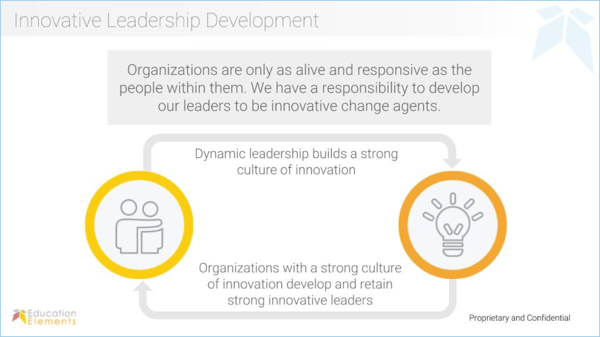 The simplest answer to this question is that innovative educational leadership can breed positive, transformative change within schools and districts. The most successful implementations and cultures of educational innovation are driven by capable leadership teams who are amply equipped to overcome evolving challenges and enhance the skills of their teachers. By building your leadership capacity and that of your team, you will establish the foundation needed to support teachers and educational leaders to more fully design, implement and sustain innovation in their classrooms and work. In many schools and districts, innovative leaders are the key difference makers in developing struggling teachers into effective ones, and good teachers into great ones.
The simplest answer to this question is that innovative educational leadership can breed positive, transformative change within schools and districts. The most successful implementations and cultures of educational innovation are driven by capable leadership teams who are amply equipped to overcome evolving challenges and enhance the skills of their teachers. By building your leadership capacity and that of your team, you will establish the foundation needed to support teachers and educational leaders to more fully design, implement and sustain innovation in their classrooms and work. In many schools and districts, innovative leaders are the key difference makers in developing struggling teachers into effective ones, and good teachers into great ones.
Strong leaders have done the work of understanding themselves and allowing others to do the same. As a result, they have a comprehensive understanding of the values and priorities of their work, and they facilitate that understanding among the school’s or district’s working groups, committees and individuals. Educational leadership fosters this critical focus on an overarching purpose, which helps others trace their individual contributions back to a theory of action, guiding communication and behavior toward a common goal.
Digging deeper into the question of why innovative educational leadership matters, here are some of the most impactful reasons:
It elevates decision-making aptitudes. District and school personnel are faced with a mounting number of decisions to be made every day. As this number increases, the quality of those decisions decreases. The fact is human decision-making abilities are limited in number each day, so it is incumbent on school leaders to prioritize certain decisions and distribute decision-making power and authority to other willing and capable individuals.
It improves delegation efforts. Given the importance of strong and robust teams, it is vital for leaders to be able to release responsibility to their team members effectively. Many individuals, however, struggle to release control of tasks, teams, and decisions, often due to fear of failure and a reluctance to acknowledge power. Strong innovative leadership overcomes this challenge and gives educational team members the opportunity to stumble, learn, and thrive.
It encourages continual learning. Without ongoing learning efforts, dynamic learning communities would not exist. Innovative educational leadership encourages teams and individuals to step outside of their comfort zones by researching a particular interest or theory, testing it out and sharing best practices with colleagues. As a result, everyone becomes more knowledgeable and benefits from cutting-edge ideas and solutions.
It enhances work culture. Gratitude and appreciation are terms often used in the context of wellness and self-improvement but utilized appropriately, small acts of thanks and expressions of appreciation help build strong work cultures. Innovative educational leadership prioritizes this aspect of
Read more about The Power of Showing Appreciation in Teams
It strengthens the ability to retain top talent. There’s an undeniable crisis in school districts to retain top talent. Exceptional teachers and leaders are needed throughout the school system, and replacing their talent and skills is challenging. Because negative cultures drive away the best, it is essential to have innovative educational leadership that sustains a healthy and quality school and district culture that compels talented teachers and staff to stay.
To learn more about talent retention, check out the following resources:
- Evolving How We Meet the Recruiting and Retention Needs at the Nation's 4th Largest School District
- 8 Elements For Improving Teacher Retention
- 40 Ways to Celebrate Teachers and Impact Teacher Retention
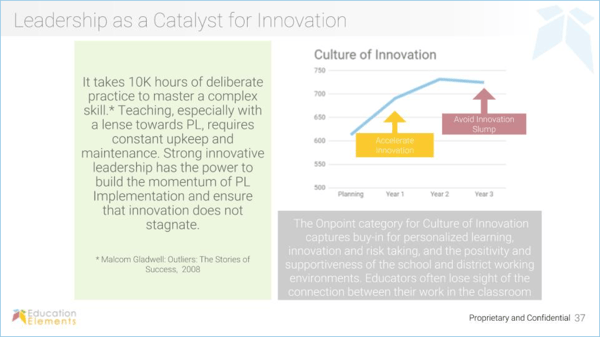 It drives widespread innovation. There are frequently pockets of teachers utilizing new, engaging instructional models, but without district leadership, these innovations are usually relegated to the self-directed, technology-savvy teachers. Efforts to scale this work often plateau due to lack of resources and formalized training. Innovative educational leadership guides initiatives from the front row to optimize impact and success.
It drives widespread innovation. There are frequently pockets of teachers utilizing new, engaging instructional models, but without district leadership, these innovations are usually relegated to the self-directed, technology-savvy teachers. Efforts to scale this work often plateau due to lack of resources and formalized training. Innovative educational leadership guides initiatives from the front row to optimize impact and success.
Ultimately, schools and districts are stronger when the people on the ground get the support they need. Innovative educational leadership is the bedrock of success in developing, supporting, and retaining excellent teachers, as well as building up teams to accomplish great things.
The primary objective of innovative leadership development should be to cultivate the kinds of leaders that sustain transformational change. To enlist and support great leaders, a successful development framework aims to support all leaders who are key to highly successful schools and districts, including:
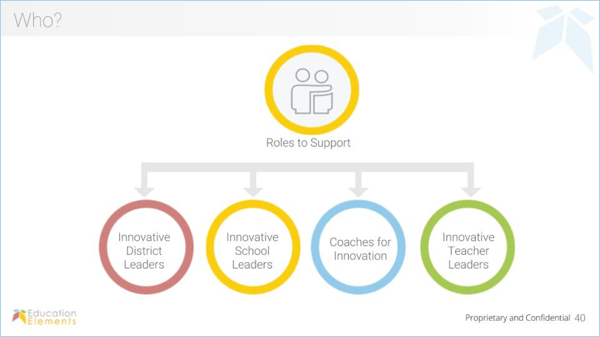
District leaders, or leaders at the district or regional level who support initiatives related to principals and teachers. Innovative leadership development among this group is effective when they can utilize elemental competencies to be more effective leaders of innovation. They should be able to report greater confidence and effectiveness in their leadership efforts, and the school and district staff should be reporting positive shifts in their leader’s practice and individualized support for personal innovation.
School leaders, or administrators such as principals, assistant principals or deans who lead campus-wide initiatives. Innovative leadership development among this group is effective when they can innovate to better meet the needs of staff and students. District leaders should be reporting that the school leaders are taking initiative to address needs in their school, and teachers should be reporting that school and district leaders are better meeting their needs. School leaders should also be able to share examples of their own innovative practices.
Coaches, or individuals who support teachers to improve instructional practice. Whether or not an individual’s title includes the word “coach,” any person who provides feedback, professional development, and coaching can play a significant role in supporting teacher innovation. Innovative leadership development among this group is effective when teachers are reporting positive shifts in the support they receive for personal improvement and innovation.
Learn more about good coaching relationships here:
- Coaching for Innovation: 10 Competencies to - Maximize the Impact of a Coach
- 5 Ways to Build a Trusting Coaching Relationship
- 5 Common Coaching Misconceptions
To get to the heart of this question, it is necessary to understand personalizing learning on a basic level. Contrary to some widely held misconceptions, it is not a demonstration of students working individually on computers for a major part of the day. While technology can support and enhance learning methods and techniques, truly personalized learning comes down to good teaching practices implemented by teachers who are prepared to learn, collaborate, reflect, take risks, and even fail on occasion to improve the learning process for their students. At its core, personalized learning is a dynamic integration of four vital elements:
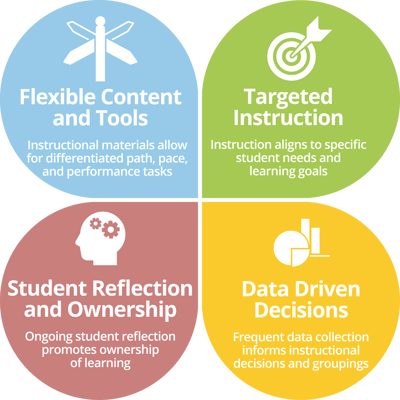
Student Reflection and Ownership: Personalized learning encourages a focus on metacognitive strategies for learning and prompts students to pursue their passions and ownership of their work.
Data-Driven Decisions: Personalized learning allows teachers and students to understand and act on their strengths and needs.
Targeted Instruction: Personalized learning provides a critical structure for teachers and students to problem-solve with one another and
Flexible Content and Tools: Personalized learning creates a mix of resources responsive to student needs and interests that allow for differentiated path, pace, and performance tasks.
Personalized learning is a practice that transforms the teaching experience for teachers and the learning experience for students. So what is the role of the innovative educational leader in this effort? It is, among other responsibilities, to:
Build trusting relationships and a culture in which teachers feel comfortable enough to consider new approaches and new data, as well as reflect and iterate.
Think differently about curriculum, ensuring that decisions are not made in a siloed or disjointed way. Instead, they should align with a widely shared vision and purpose for personalizing instruction.
Foster the engagement, transparency, and trust that is critical for innovation to both take hold in the classroom and be sustainable and scalable across many schools.
Develop and communicate a clear vision and narrative about personalized learning, thereby supporting opportunities to identify early wins or proof points of success that help increase buy-in and offer exemplars of good practice.
Create
Implement a plan to select and support the appropriate learning devices and curriculum, both technically and financially.

Check out our Ultimate Guide for Personalized Learning, a comprehensive personalized learning guide for educators, administrators, and parents that provides a curated set of resources and literature about how personalized learning is most effectively applied in K-12 settings, alongside many of the tools and resources that we have internally developed to help our district partners launch, implement and sustain personalized learning.
In a diagnostic framework from Harvard Professor Dean Williams’ book Real Leadership, Williams argues that good leaders do not simply create followers; rather, they facilitate learning within and across groups in order to address complex realities that demand change. He says that the true task of a leader is getting people to face the reality of any situation themselves, thereby prompting them to develop their own strategies for dealing with problems. In doing that work, a variety of challenges may emerge, which Williams organizes into six primary domains that fittingly describe the major challenges hindering educational leadership in today’s school districts. An innovative leadership approach can help address these challenges in the following ways:
1. The Activist Challenge
In an activist challenge, a group’s values and principles may not reflect the reality of the choices it makes or the systems it has in place. In the classroom, this can occur if a school espouses the belief that students learn at different paces but has no systems for students to make up work or receive extra support if they fall behind.
>>The Innovative Leader Approach: Help a group align its values with its systems, structures, and actions. This involves developing a strategy based on a clear vision and plans for implementing system-wide shifts to personalized learning or competency-based education.
2. The Development Challenge
In a development challenge, a group has untapped potential that is simply not yet developed. For example, it may be present in staffing models in which all teachers have the exact same responsibilities, even though some may be well-suited for coaching or curriculum work beyond the four walls of their classroom.
>>The Innovative Leader Approach: Tap into the raw potential of the group and bring out latent capabilities that are overlooked or simply stifled by current systems.
3. The Transition Challenge
In a transition challenge, if the current value set shifts to a new value set, great progress can be made by the organization. Consider Professor Todd Rose’s work challenging the conventional wisdom of averages in favor of individuality and “jaggedness” in education, as well as technology’s role in accelerating and supporting that process. In the classroom, this challenge can be seen in getting students to shift from an “I’m not smart” mindset to an “I’m able to learn if I try” mindset.
>>The Innovative Leader Approach: Help a group unpack its current beliefs and principles in order to embrace a new set of ideas that can improve performance.
4. The Maintenance Challenge
In a maintenance challenge, a group must weather changing circumstances and preserve the work it has done in order to be able to move forward in the future. This took place a few years ago as Common Core support eroded in state legislatures, and leaders were left alone to adjust to changing state standards and assessments. Effective leaders and teachers had been focused on the broader competencies and principles of teaching and learning that allowed practitioners to stay focused on a coherent instructional vision. Those who were hyper-focused on specific tests or curricular materials faced a more difficult battle in adjusting to a changing landscape.
>>The Innovative Leader Approach: Preserve the essentials and keep performance at a high level until a threat passes or the unknown becomes known.
5. The Creative Challenge
In a creative challenge, a new opportunity arises that gives a group a window to explore new ways of thinking and doing in hopes of making a permanent and lasting change for the organization. This is often the “innovation” work that schools are charged to tackle through grants like Next Generation Learning Challenges, the XQ Super School Project or Race to the Top funding. It might also come in the form of a community passing a penny tax to fund new resources for schools, an election that allows for a fresh start with a new school board majority, or a chance for leaders to enact policy waivers that enable new work.
>>The Innovative Leader Approach: Imagine new realities, develop curiosity about possible solutions, and connect partners across the country doing similar work.
6. The Crisis Challenge
In a crisis challenge, a group faces an unexpected event or change in circumstances that threatens its ways of working or even its very existence. This might occur when a state or district takes over management of schools, or when an abrupt shift in leadership occurs within an organization.
>>The Innovative Leader Approach: Establish a process to deescalate the situation and then focus on addressing the key issues that led to the crisis in order to prevent its recurrence.
Whatever challenges your school or district faces, an innovative educational leadership approach will require a mix of short-term steps and long-term planning to address key structures in the organization as well as the changing circumstances that surround them. It can be a complex endeavor, one that requires a strong framework for moving through the process and determining the precise challenges your school or district is up against.
Implementing school improvements that are sustained over the long term is no easy feat. It’s a challenge that requires the development of effective, innovative leaders who are equipped to support the people moving the work forward and build up the teams accomplishing these goals.
Leadership capacity building is fundamental to this effort, as it enables people to improve in some of the following critical ways:
In general, educational leaders tend to gravitate toward one of the following leadership styles:
The Cleaner: Prefers to minimize failure and to avoid making mistakes in their work and leadership.
The Peacemaker: Prefers to build consensus and include as many people as possible in decision-making.
The Planner: Prefers to develop detailed plans and seek perfection in planning and execution.
The General: Prefers to control the flow of information and use a centralized decision-making system.
Each of these types features its own strengths and weaknesses, but all should strive to adopt an innovative leadership style. Why? Because without innovation, education is stagnant and progress is impossible.
“Most education systems in North America are still reliant on an assembly-model way of teaching and thinking. Consider the structure of most schools: there are grades, segregated by age; there are alarm bells, which tell students when to move from one classroom to the next; and the most common form of learning is to sit passively and absorb lectured lessons.
More subtly, subjects get taught according to a linear progression. Math education in the United States, for example, moves from algebra to geometry, to advanced algebra, to precalculus, to calculus. This sequence trains students to think about math in a way that only entrenches a hierarchical, linear view of how the world works. Simply put, schools in the 21st century are still designed to produce people to work in factories.
Exciting possibilities emerge when we dare to reinvent institutions like the U.S. education system by experimenting with new approaches that leverage technology and use innovative models of collaborating. What is necessary is the willingness to experiment.”
– Robin P. Zander, founder of The Responsive Conference
Leaders must intentionally create space for innovation and encourage their staff to embrace risk-taking. Ultimately, key leadership roles can impact an entire culture of innovation.
Anthony Kim, CEO, and Founder of Education Elements
The most successful leaders of innovative, transformational change in their educational communities are equipped to leverage some of the following general competencies:
Knowing yourself: Understand how personal experiences, values, and strengths impact practices and interactions.
Knowledge of self is powerful because it can lead to genuine respect and appreciation of other people’s values. Additionally, knowing what you stand for can help you identify when and why the behaviors, actions, or beliefs of others clash with your own. This work encourages you to dig deep within yourself, a process that can bring up pain while uncovering inner strength. Knowing yourself is the key ingredient to creating a space where others can do the same.
Nurturing trust: Build deep trust by creating a space where people feel safe to share feedback and ask questions.
Creating a space where individuals can explore their identities inevitably leads to a place where difficult questions and conversations emerge, ones that foster greater trust. Trusting environments lead to strong teams, and strong teams lead to innovation. Imagine what could be accomplished by intentionally building school cultures that nurture trust: trust to explore, experiment, fail, and learn. Consider the ripple effects this could have on teaching, learning, and problem-solving. When you commit to the challenging work of trust-building, you spark possibility and innovation.
Check out what our board member, Howard Behard - former president of Starbucks Coffee Company, advisor, and author - says about investing in people and nurturing trust, on his guest post Putting People First - The Path to True Success
Cultivating curiosity: Seek out ways for self and others to constantly ask questions, learn, and share.
Some of the best accomplishments are spurred by individuals who explore a particular interest and push the team to expand their perspectives. In districts where significant growth is achieved, communities of learning emerge. Creating a culture of curiosity has immense benefits, such as fewer decision-making errors, more innovation
The innovative leadership competencies that apply specifically to individual leadership roles include:
The cultivation of innovative leadership skills requires training and support in the areas of competency listed above. Targeted growth can occur by intentionally building knowledge and developing skills that are central to effectively applying each specific component of innovative leadership. Begin examining your current educational leadership and reflecting on the competencies integral to success.
Check out this article: Transformation of a Leader by Dr. Karen Gaborik, Superintendent of Schools at Fairbanks North Star Borough School District, AK.
It is necessary to develop a framework for leveraging innovative leadership competencies, one that provides the insights, tools, and training to:
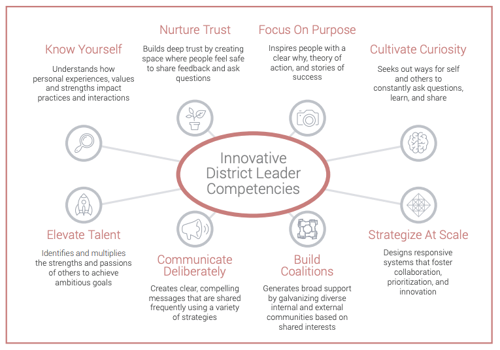 Equip district leaders to better support school leaders and teachers as innovators by learning to:
Equip district leaders to better support school leaders and teachers as innovators by learning to:Check out the Innovative District Leader Competencies Framework
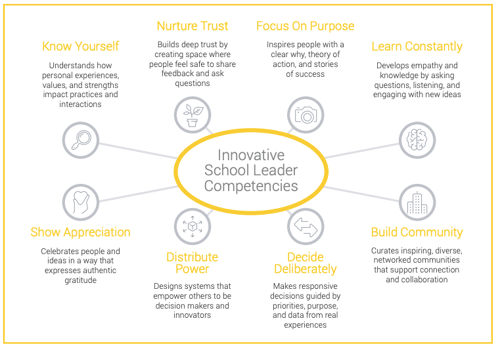 Equip school leaders to better support teachers as innovators by learning to:
Equip school leaders to better support teachers as innovators by learning to:Check out the Innovative School Leader Competencies Framework.
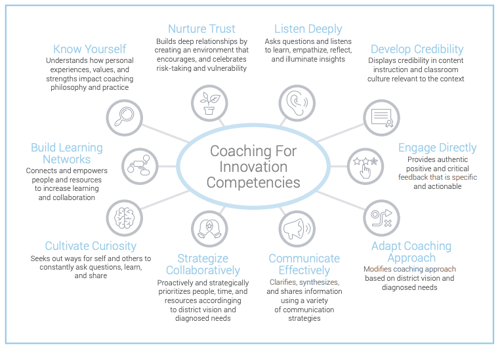 Equip coaches to better support teachers as innovators by learning to:
Equip coaches to better support teachers as innovators by learning to:
Check out the Coaching for Innovation Competencies Framework
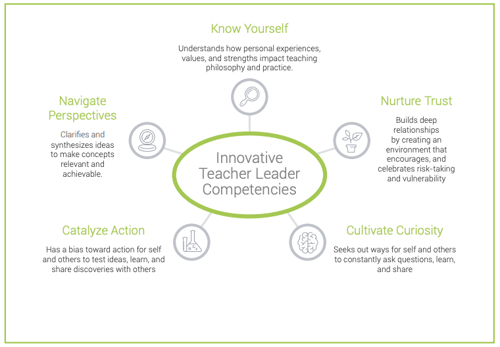 Equip teacher-leaders to better foster innovation in themselves and their colleagues by learning to:
Equip teacher-leaders to better foster innovation in themselves and their colleagues by learning to:Check out the Innovative Teacher-Leader Competencies Framework
Responsive leaders have the skills and mindset to learn and respond rapidly through an open flow of information; encourage experimentation and learning on rapid cycles; and organize a network of employees, customers, and partners motivated by a shared purpose.
To improve how their teams collaborate, make decisions, and achieve goals, innovative leaders can help their schools and districts be responsive organizations by:
The NEW School Rules: 6 Vital Practices for Thriving and Responsive Schools is a practical guide for how to improve the practices of schools and districts, as well as a thoughtful examination of the self-imposed barriers that can get in the way of getting work done in organizations. These six rules are the culmination of eight years of research, as well as work with over 750 schools and 140 districts, based on the practices that have the biggest impact on how organizations function and how work gets done. They provide valuable insight into how innovative leaders can help their schools or districts be responsive organizations.
Rule 1: Planning
“Plan for Change, Not Perfection”
As U.S. General Dwight Eisenhower said, “In preparing for battle, I have always found that plans are useless, but planning is indispensable.” We need to stick vigilantly to our purpose, not the plans we make to get us there. We need to approach planning as a way of thinking, not a set “product” or “plan” that has value in and of itself.
Rule 2: Teaming
“Build Trust and Allow Authority to Spread”
Working in teams is the norm for most organizations, but our understanding of teamwork and team roles is often shaped by legacy, hierarchical systems. As organizations focus on becoming more responsive, we need new ground rules for how to align on purpose, how to share authority, and how to structure team meetings.
Rule 3: Managing Roles
“Define the Work Before You Define the People”
We often think of our role as our job title, but roles are actually fluid and change frequently based on the needs of teams and organizations. Rethinking the relationship between roles, accountabilities, and people is an essential component in changing the way work gets done and decisions get made within and across teams.
Rule 4: Decision-Making
“Aim for ‘Safe Enough to Try’ versus Consensus”
As individuals, we make hundreds of decisions every day. As organizations, however, we often lack systems to help groups of people make decisions. By granting authority to others and aiming for safe enough to try instead of consensus, we can help our teams make decisions in a way that is effective, efficient, and empowering.
Rule 5: Sharing Information
“Harness the Flow and Let Information Go”
We all know that information is valuable and needs to be shared, but we often get bogged down in determining the right size, the right audience, and the right time for sharing information. By rethinking our systems for sharing information we can find new ways to increase alignment and collaboration across our organization.
Rule 6: The Learning Organization
“Schools Grow When People Grow”
The organizations that are most successful, innovative, and happy are those that are able to cultivate a learner’s mindset across individuals and teams. The process of identifying a learning goal, learning, reflecting, and applying learning is powerful for both your people and your organization.

The NEW School Rules: 6 Vital Practices for Thriving and Responsive Schools is both a practical guide for how to improve the practices of schools and districts as well as a thoughtful examination of the self-imposed barriers that can get in the way of getting work done in organizations. Designed to be actionable, the book offers leaders the ability to implement immediate change in order to have a lasting impact. While many books in education focus on curriculum, budgeting, technology or talent, The NEW School Rules focuses on processes, people and organizations. It is a game-changer in the education space.
For more information on how these rules can benefit every leader who wants to effectively make
One of the single most impactful efforts a district can undertake is to help their district leaders, school leaders, instructional coaches, and teacher-leaders learn to practice innovative leadership. Innovative leaders are culture-shapers, curiosity-kindlers, network-connectors, and trust-builders. They are not necessarily the people with the best ideas, but rather the people who nurture, spark, encourage, and celebrate creative and courageous thinking by teachers.
In some ways, educational innovation is a set of concentric circles. In the innermost circle, students are at the center of a dynamic and thriving classroom led by their teacher. The rings of support that encircle that classroom – maintained and bolstered by coaches, principals
Supporting teachers in this pattern of concentric circles, and creating organic and dynamic schools with a bias toward action as well as a comfort with teacher innovation and risk-taking, requires leaders to bring a new set of practices and mindsets to bear. Education Elements’ Innovative Leadership Development Methodology is designed to build the ability of all educational leaders to affect transformational change by supporting and energizing classroom-level innovation.
Start creating positive change in your schools by asking, “What do teachers need in order to transform education, and what can leaders do to support teachers in that work?” The innovative leadership competencies developed by Education Elements can serve as a blueprint for all sorts of districts, schools, and educators interested in more impactful ways of supporting teachers and driving innovation. Join us in this work, using our leadership competencies or creating your own, as a way to shed new light on conversations about educational innovation.
Being a new superintendent is challenging for many reasons. You need to balance the need to listen with the need to act. You need to hear from everyone but be able to filter and understand the context behind their comments. You need to hope for candor but recognize you may not always get total honesty. You want to please as many people as you can.
A new superintendent always needs extra eyes and ears to learn everything necessary, as quickly as possible, to develop a plan for how to support the district in achieving its goals. You need a team who can listen, who can synthesize, and who can make recommendations so that you can hear everything but not have the process take too long.
Check out this post: Four Actions to Make Your First Year As a Superintendent Count

We respond to requests immediately, so we’ll get back to you super fast to set up a time to chat.